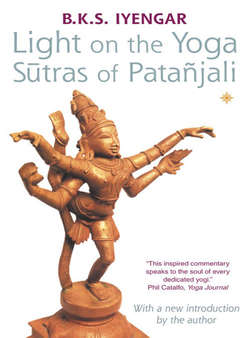Читать книгу Light on the Yoga Sutras of Patanjali - Литагент HarperCollins USD - Страница 36
Asana and its effects
ОглавлениеAsana means posture, the positioning of the body as a whole with the involvement of the mind and soul. Asana has two facets, pose and repose. Pose is the artistic assumption of a position. ‘Reposing in the pose’ means finding the perfection of a pose and maintaining it, reflecting in it with penetration of the intelligence and with dedication. When the seeker is closer to the soul, the Asanas come with instantaneous extension, repose and poise.
In the beginning, effort is required to master the Asanas. Effort involves hours, days, months, years and even several lifetimes of work. When effortful effort in an Asana becomes effortless effort, one has mastered that Asanas, In this way, each Asana has to become effortless. While performing the Asanas, one has to relax the cells of the brain, and activate the cells of the vital organs and of the structural and skeletal body. Then intelligence and consciousness may spread to each and every cell.
The conjunction of effort, concentration and balance in Asana forces us to live intensely in the present moment, a rare experience in modern life. This actuality, or being in the present, has both a strengthening and a cleansing effect: physically in the rejection of disease, mentally by ridding our mind of stagnated thoughts or prejudices; and, on a very high level where perception and action become one, by teaching us instantaneous correct action; that is to say, action which does not produce reaction. On that level we may also expunge the residual effects of past actions.
The three origins of pain are eradicated by Asana as we progress from clear vision through right thinking to correct action.
To the new student or non-practitioner of yoga a relentless pursuit of perfection in Asana may seem pointless. To advanced students, a teacher teaches a whole Asana in relationship to what is happening in a single action. At this subtlest level, when we are able to observe the workings of rajas, tamas and sattva in one toe, and to adjust the flow of energy in ina, pitgala and susumna (the three principal nanis, or energy channels), the macrocosmic order of nature is perceived in even the smallest aspects. And when the student then learns how the minutest modifications of a toe can modify the whole Asana, he is observing how the microcosm relates to the whole, and the organic completeness of universal structure is grasped.
The body is the temple of the soul. It can truly become so if it is kept healthy, clean and pure through the practice of Asana.
Asanas act as bridges to unite the body with the mind, and the mind with the soul. They lift the sadhaka from the clutches of afflictions and lead him towards disciplined freedom. They help to transform him by guiding his consciousness away from the body towards awareness of the soul.
Through Asana, the sadhaka comes to know and fully realize the finite body, and merge it with the infinite – the soul. Then there is neither the known nor the unknown and only then does the Asana exist wholly. This is the essence of a perfect Asana.
